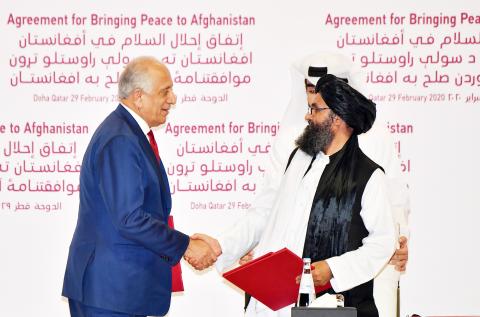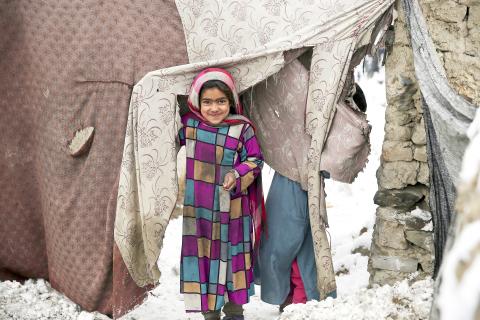The US signed a historic deal with the Taliban in Doha on Feb. 29, laying out a timetable for a full American troop withdrawal from Afghanistan within 14 months. The agreement is set to lead to dialogue between the Taliban and the Kabul government that could potentially pave the way to an end to the 18-year conflict.
The Taliban governed Afghanistan between 1996 and 2001, imposing strict Islamic sharia law before being ousted and launching an insurgency. Here is some background on the movement:
Religious students

Photo: AFP
照片:法新社
The Taliban originated among young Afghans who studied in Sunni Islamic schools called madrassas in Pakistan after fleeing Afghanistan during the 1979-1989 Soviet occupation.
They take their name from talib, the Arabic word for student.
In the early 1990s, with Afghanistan in the chaos and corruption of civil war, the Taliban was formed in the southern province of Kandahar under the leadership of one-eyed warrior-cleric Mullah Omar.

Photo: AP
照片:美聯社
Omar, who led them until his death in 2013, was from a stronghold of the powerful Pashtun ethnic group from which come most Taliban fighters. Haibatullah Akhundzada is now the top leader, while Taliban co-founder Mullah Baradar heads the political wing.
Dramatic rise to power
Promising to restore order and justice, the Taliban rose dramatically. They drew substantial support from Pakistan and initially had the tacit approval of the US. In October 1994, they seized the city of Kandahar, almost without a fight.
Equipped with tanks, heavy weapons and the cash to buy the support of local commanders, they steadily moved north, before capturing the capital Kabul on Sept. 27, 1996. Then-Afghanistan president Burhanuddin Rabbani had already fled.
Reign of terror
The Taliban government imposed the strictest interpretations of sharia, or Islamic laws, establishing religious police for the suppression of “vice.”
Music, television and pastimes such as kite-flying were banned. Girls’ schools were closed, while women were prevented from working and forced to wear an all-covering burkha in public.
Taliban courts handed out extreme punishments including chopping off the hands of thieves and stoning to death women accused of adultery.
By 1998, they had control of 80 percent of the country, but were only recognized as the legal government by Pakistan, the United Arab Emirates and Saudi Arabia.
In March 2001 they blew up 1,500-year-old giant statues of the Buddha in the central Bamiyan valley.
The Taliban allowed Afghanistan to become a sanctuary for Al-Qaeda, which set up training camps.
Taliban toppled
The Sept. 11, 2001 attacks that killed 3,000 people in the US were immediately blamed on Al-Qaeda. Accusing the Taliban of refusing to hand over the then al-Qaeda leader Osama bin Laden, the US and allies launched air strikes on Afghanistan in October.
By early December the Taliban government had fallen, its leaders fleeing to their strongholds in the south and east, or back across the border into Pakistan’s tribal zone.
Bloody insurgency
At first written off as a spent force, the Taliban rebuilt and re-emerged to lead an insurgency against the new Western-backed government.
Making heavy use of improvised bombings and suicide attacks, they labelled “crusaders” the tens of thousands of foreign troops who deployed into the country as part of a US-dominated NATO force. The NATO combat mission ended in December 2014 and the bulk of Western forces withdrew.
The rival Islamic State jihadist group emerged in Afghanistan in 2015, launching its own series of devastating attacks, mainly on Kabul.
A UN tally found that 2018 was the deadliest year on record for Afghans, with at least 3,804 civilian deaths — including 927 children.
(AFP)
美國與阿富汗民兵組織塔利班二月二十九日在卡達首都多哈簽署了一項歷史性協議,為美國在十四個月內自阿富汗全面撤軍制定了時間表。該協議將促使塔利班與喀布爾政府進行對話,為結束十八年的阿富汗戰爭鋪路。
塔利班在一九九六年至二○○一年間統治阿富汗,實施嚴格的伊斯蘭教法。其政權被推翻後,塔利班發動叛亂。以下為塔利班之背景介紹:
神學士
塔利班是由一群阿富汗年輕人所發起,他們在一九七九至一九八九年蘇聯佔領期間逃離阿富汗,在巴基斯坦的遜尼派伊斯蘭學校學習。
「塔利班」(Taliban)之名,便是取自「talib」一字,為阿拉伯文的「學生」之意。
一九九○年代初,阿富汗處於內戰的混亂與腐敗時,塔利班在獨眼教士兼戰士毛拉.歐瑪的領導下,成立於南部的坎達哈省。
歐瑪領導塔利班直到他二○一三年去世為止,他來自強大的普什圖族的大本營,塔利班的大多數戰士皆來自此地。哈巴圖拉‧艾昆薩達現為塔利班最高領導人,塔利班共同創立者毛拉‧巴拉達則領導政治部門。
快速崛起
塔利班承諾要恢復秩序與正義,因此迅速崛起。他們得到巴基斯坦的大力支持,最初還得到美國的默許。一九九四年十月,他們幾乎沒有戰鬥就佔領了坎達哈市。
他們擁有坦克、重型武器,以及用來收買當地指揮官的現金,穩步向北移動,然後在一九九六年九月二十七日占領了首都喀布爾。此時阿富汗總統布爾漢丁‧拉巴尼已然逃遁。
恐怖統治
塔利班政府採取最嚴格解釋的伊斯蘭教法,設立宗教警察來鎮壓「傷風敗俗的行為」。
音樂、電視及放風箏等消遣娛樂活動均被禁止。女子學校被關閉、婦女被禁止工作,並被迫在公共場合穿上全遮蓋的布爾卡罩袍。
塔利班法院頒布了嚴厲的懲罰措施,包括砍掉小偷的手、將被控犯通姦罪的婦女用石頭砸死。
到了一九九八年,塔利班已控制了阿富汗百分之八十的疆域,但只有巴基斯坦、阿拉伯聯合大公國及沙烏地阿拉伯承認其為合法政府。
二○○一年三月,塔利班炸毀了巴米揚山谷中部有一千五百年歷史的巨型佛像。
塔利班讓阿富汗成為蓋達組織的庇護所,讓蓋達組織在境內設立訓練營。
塔利班政權垮台
二○○一年九月十一日在美國造成三千人死亡的攻擊發生後,美國立即指控蓋達組織為該恐攻之背後主腦。美國及其盟國指責塔利班拒絕交出賓拉登,而在十月對阿富汗發動空襲。
到了十二月初,塔利班政府已經垮台,其領導人逃往南部及東部的據點,或越過邊界到巴基斯坦的部落地區。
血腥叛亂
塔利班在其政權垮台後,起初被鄙視為權力及影響力不再,但他們後來重整旗鼓,策畫了叛亂與暴動,意圖顛覆西方所支持的阿富汗新政府。
他們大量運用土製炸彈與自殺式攻擊,將美國主導之北約部隊部署在阿富汗的成千上萬外國兵力稱為「十字軍」。北約的作戰任務於二○一四年十二月結束,大部分的西方部隊隨之撤離。
塔利班的競爭對手「伊斯蘭國」聖戰組織二○一五年在阿富汗興起,發動了一系列毀滅性的攻擊,主要在喀布爾。
聯合國統計顯示,二○一八年是阿富汗人有記錄以來死傷最慘重的一年,在這一年至少有三千八百零四名平民死亡──其中包括九百二十七名兒童。
(台北時報林俐凱編譯)
FOLLOW UP 讀後練習
Reading Comprehension
1. What agreement was signed between the US and the Taliban on Feb. 29 over Afghanistan? What is its potential outcome?
2. When and how did the Taliban rise to power?
3. Describe the role the Taliban played in the 911 terrorist attack in 2001 and its consequences.
4. How did the Taliban government rule in Afghanistan?
(Lin Lee-kai, Taipei Times)

In an effort to fight phone scams, British mobile phone company O2 has introduced Daisy, an AI designed to engage phone con artists in time-wasting conversations. Daisy is portrayed as a kindly British granny, exploiting scammers’ tendency to target the elderly. Her voice, based on a real grandmother’s for authenticity, adds to her credibility in the role. “O2” has distributed several dedicated phone numbers online to direct scammers to Daisy instead of actual customers. When Daisy receives a call, she translates the scammers’ spoken words into text and then responds to them accordingly through a text-to-speech system. Remarkably, Daisy

Bilingual Story is a fictionalized account. 雙語故事部分內容純屬虛構。 Emma had reviewed 41 resumes that morning. While the ATS screened out 288 unqualified, she screened for AI slop. She could spot it a mile away. She muttered AI buzzwords like curses under her breath. “Team player.” “Results-driven.” “Stakeholder alignment.” “Leveraging core competencies.” Each resume reeked of AI modeling: a cemetery of cliches, tombstones of personality. AI wasn’t just changing hiring. It was draining the humanity from it. Then she found it: a plain PDF cover letter. No template. No design flourishes. The first line read: “I once tried to automate my

Every May 1, Hawaii comes alive with Lei Day, a festival celebrating the rich culture and spirit of the islands. Initiated in 1927 by the poet Don Blanding, Lei Day began as a tribute to the Hawaiian custom of making and wearing leis. The idea was quickly adopted and officially recognized as a holiday in 1929, and leis have since become a symbol of local pride and cultural preservation. In Hawaiian culture, leis are more than decorative garlands made from flowers, shells or feathers. For Hawaiians, giving a lei is as natural as saying “aloha.” It shows love and

1. 他走出門,左右看一下,就過了馬路。 ˇ He walked outside, looked left and right, and crossed the road. χ He walked outside and looked left and right, crossed the road. 註︰並列連接詞 and 在這句中連接三個述語。一般的結構是 x, y, and z。x and y and z 是加強語氣的結構,x and y, z 則不可以。 2. 他們知道自己的弱點以及如何趕上其他競爭者。 ˇ They saw where their weak points lay and how they could catch up with the other competitors. χ They saw where their weak points lay and how to catch up with the other competitors. 註:and 一般連接同等成分,結構相等的單詞、片語或子句。誤句中 and 的前面是子句,後面是不定詞片語,不能用 and 連接,必須把不定詞片語改為子句,and 前後的結構才相等。 3. 她坐上計程車,直接到機場。 ˇ She took a cab, which took her straight to the airport. ˇ She took a cab and it took her straight